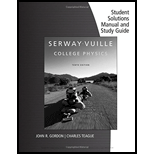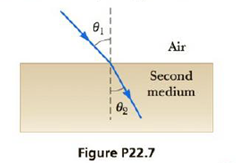
EBK STUDENT SOLUTIONS MANUAL WITH STUDY
10th Edition
ISBN: 9781337520379
Author: Vuille
Publisher: YUZU
expand_more
expand_more
format_list_bulleted
Concept explainers
Textbook Question
Chapter 22, Problem 7P
A ray of light travels from air into another medium, making an angle of θ1 = 45.0° with the normal as in Figure P22.7. Find the angle of refraction θ2 if the second medium is (a) fused quartz, (b) carbon disulfide, and (c) water.

Expert Solution & Answer
Want to see the full answer?
Check out a sample textbook solution
Students have asked these similar questions
Identical rays of light enter three transparent blocks composed of
different materials. Light slows down upon entering the blocks.
For single-slit diffraction, calculate the first three values of (the total phase difference between rays from each
edge of the slit) that produce subsidiary maxima by a) using the phasor model, b) setting dr = 0, where I is
given by,
I
=
Io (sin (10) ².
2
A capacitor with a capacitance of C = 5.95×10−5 F is charged by connecting it to a 12.5 −V battery. The capacitor is then disconnected from the battery and connected across an inductor with an inductance of L = 1.55 H .
(D)What is the charge on the capacitor 0.0235 s after the connection to the inductor is made? Interpret the sign of your answer. (e) At the time given in part (d), what is the current in the inductor? Interpret the sign of your answer. (f) Atthe time given in part (d), how much electrical energy is stored in the capacitor and how much is stored in the inductor?
Chapter 22 Solutions
EBK STUDENT SOLUTIONS MANUAL WITH STUDY
Ch. 22.2 - Which part of Figure 22.3, (a) or (b), better...Ch. 22.2 - Prob. 22.2QQCh. 22.3 - A material has an index of refraction that...Ch. 22.3 - As light travels from a vacuum (n = 1) to a medium...Ch. 22 - Prob. 1CQCh. 22 - A ray of light passes from one material into a...Ch. 22 - Prob. 3CQCh. 22 - Prob. 4CQCh. 22 - Determine whether each of the following statements...Ch. 22 - A type of mirage called a pingo is often observed...
Ch. 22 - In dispersive materials, the angle of refraction...Ch. 22 - The level of water in a clear, colorless glass can...Ch. 22 - Prob. 9CQCh. 22 - Light in medium A undergoes a total internal...Ch. 22 - Prob. 11CQCh. 22 - Try this simple experiment on your own. Take two...Ch. 22 - Prob. 13CQCh. 22 - Prob. 14CQCh. 22 - A light ray containing both blue and red...Ch. 22 - During the Apollo XI Moon landing, a...Ch. 22 - Prob. 2PCh. 22 - Prob. 3PCh. 22 - Prob. 4PCh. 22 - Prob. 5PCh. 22 - Find the speed of light in (a) water, (b) crown...Ch. 22 - A ray of light travels from air into another...Ch. 22 - Prob. 8PCh. 22 - An underwater scuba diver sees the Sun at an...Ch. 22 - Prob. 10PCh. 22 - A laser beam is incident at an angle of 30.0 to...Ch. 22 - Light containing wavelengths of 400. nm, 500. nm,...Ch. 22 - A ray of light is incident on the surface of a...Ch. 22 - Prob. 14PCh. 22 - The light emitted by a helium-neon laser has a...Ch. 22 - Figure P22.16 shows a light ray traveling in a...Ch. 22 - Prob. 17PCh. 22 - A ray of light strikes a flat, 2.00-cm-thick block...Ch. 22 - Prob. 19PCh. 22 - Prob. 20PCh. 22 - A man shines a flashlight from a boat into the...Ch. 22 - A narrow beam of ultra-sonic waves reflects off...Ch. 22 - A person looking into an empty container is able...Ch. 22 - Prob. 24PCh. 22 - Prob. 25PCh. 22 - Prob. 26PCh. 22 - An opaque cylindrical tank with an open top has a...Ch. 22 - A certain kind of glass has an index of refraction...Ch. 22 - The index of refraction for red light in water is...Ch. 22 - The index of refraction for crown glass is 1.512...Ch. 22 - A light beam containing red and violet wavelengths...Ch. 22 - Prob. 32PCh. 22 - A ray of light strikes the midpoint of one face of...Ch. 22 - For light of wavelength 589 nm. calculate the...Ch. 22 - Repeat Problem 34, but this time assume the...Ch. 22 - A beam of light is incident from air on the...Ch. 22 - Prob. 37PCh. 22 - Prob. 38PCh. 22 - A light ray is incident normally to the long face...Ch. 22 - Prob. 40PCh. 22 - A room contains air in which the speed of sound is...Ch. 22 - Prob. 42PCh. 22 - The light beam in Figure P22.43 strikes surface 2...Ch. 22 - Prob. 44PCh. 22 - A layer of ice having parallel sides floats on...Ch. 22 - A ray of light is incident at an angle 30.0 on a...Ch. 22 - When a man stands near the edge of an empty...Ch. 22 - Prob. 48APCh. 22 - Refraction causes objects submerged in water to...Ch. 22 - A narrow beam of light is incident from air onto a...Ch. 22 - Prob. 51APCh. 22 - Endoscopes are medical instruments used to examine...Ch. 22 - A piece of wire is bent through an angle . The...Ch. 22 - Prob. 54APCh. 22 - Prob. 55APCh. 22 - Prob. 56APCh. 22 - Prob. 57APCh. 22 - Students allow a narrow beam of laser light to...Ch. 22 - Prob. 59APCh. 22 - Three sheets of plastic have unknown indices of...Ch. 22 - A person swimming underwater on a bright day and...Ch. 22 - Prob. 62AP
Knowledge Booster
Learn more about
Need a deep-dive on the concept behind this application? Look no further. Learn more about this topic, physics and related others by exploring similar questions and additional content below.Similar questions
- Close-up view etermine; The volume of the object given that the initial level of water in the measuring cylinder 23cm3. The density of the object. simple cell made by dipping copper and zinc plates into dilute sulfuric acid solution. A bull onnected across the plates using a wire. State what constitute current flow through the wire The bulb connected across is observed to light for some time and then goes out. State t possible asons for this observation. State two ways in which the processes named in question (b) above can be minimized t the bulb light for a longer period. ead is rated 80Ah. Determine the current that can be drawn continuouslyarrow_forwardAnswers with -1.828, -1.31 or 939.3 are not correct.arrow_forwardThree slits, each separated from its neighbor by d = 0.06 mm, are illuminated by a coherent light source of wavelength 550 nm. The slits are extremely narrow. A screen is located L = 2.5 m from the slits. The intensity on the centerline is 0.05 W. Consider a location on the screen x = 1.72 cm from the centerline. a) Draw the phasors, according to the phasor model for the addition of harmonic waves, appropriate for this location. b) From the phasor diagram, calculate the intensity of light at this location.arrow_forward
- A Jamin interferometer is a device for measuring or for comparing the indices of refraction of gases. A beam of monochromatic light is split into two parts, each of which is directed along the axis of a separate cylindrical tube before being recombined into a single beam that is viewed through a telescope. Suppose we are given the following, • Length of each tube is L = 0.4 m. • λ= 598 nm. Both tubes are initially evacuated, and constructive interference is observed in the center of the field of view. As air is slowly let into one of the tubes, the central field of view changes dark and back to bright a total of 198 times. (a) What is the index of refraction for air? (b) If the fringes can be counted to ±0.25 fringe, where one fringe is equivalent to one complete cycle of intensity variation at the center of the field of view, to what accuracy can the index of refraction of air be determined by this experiment?arrow_forward1. An arrangement of three charges is shown below where q₁ = 1.6 × 10-19 C, q2 = -1.6×10-19 C, and q3 3.2 x 10-19 C. 2 cm Y 93 92 91 X 3 cm (a) Calculate the magnitude and direction of the net force on q₁. (b) Sketch the direction of the forces on qiarrow_forward(Figure 1)In each case let w be the weight of the suspended crate full of priceless art objects. The strut is uniform and also has weight w Find the direction of the force exerted on the strut by the pivot in the arrangement (a). Express your answer in degrees. Find the tension Tb in the cable in the arrangement (b). Express your answer in terms of w. Find the magnitude of the force exerted on the strut by the pivot in the arrangement (b). Express your answer in terms of w.arrow_forward
- (Figure 1)In each case let ww be the weight of the suspended crate full of priceless art objects. The strut is uniform and also has weight w. Find the direction of the force exerted on the strut by the pivot in the arrangement (b). Express your answer in degrees.arrow_forwardA 70.0 cm, uniform, 40.0 N shelf is supported horizontally by two vertical wires attached to the sloping ceiling (Figure 1). A very small 20.0 N tool is placed on the shelf midway between the points where the wires are attached to it. Find the tension in the left-hand wire. Express your answer with the appropriate units.arrow_forwardFind the total bind Mev. binding energy for 13 Carbon, 6C (atomic mass = 13.0033554)arrow_forward
- What is the 27 energy absorbed in this endothermic Auclear reaction 2] Al + 'n → 27 Mg + ! H? (The atom mass of "Al is 26.981539u. and that of 11 Mg is 26.984341u) MeVarrow_forwardWhat is the energy released in this nuclear reaction 1 F + "', H-1 O+ He? 19 19 16 (The atomic mass of 1F is 18.998403 u, and that of 20 is 15.9949154) MeV.arrow_forwardWhat is the energy released in this B+ nuclear reaction خالد 2½ Al w/ Mg + ie? (The atomic mass of 11 Al is 23.9999394 and that > of 12 Mg is 23.985041 u) MeV.arrow_forward
arrow_back_ios
SEE MORE QUESTIONS
arrow_forward_ios
Recommended textbooks for you
 College PhysicsPhysicsISBN:9781285737027Author:Raymond A. Serway, Chris VuillePublisher:Cengage Learning
College PhysicsPhysicsISBN:9781285737027Author:Raymond A. Serway, Chris VuillePublisher:Cengage Learning College PhysicsPhysicsISBN:9781305952300Author:Raymond A. Serway, Chris VuillePublisher:Cengage Learning
College PhysicsPhysicsISBN:9781305952300Author:Raymond A. Serway, Chris VuillePublisher:Cengage Learning Principles of Physics: A Calculus-Based TextPhysicsISBN:9781133104261Author:Raymond A. Serway, John W. JewettPublisher:Cengage Learning
Principles of Physics: A Calculus-Based TextPhysicsISBN:9781133104261Author:Raymond A. Serway, John W. JewettPublisher:Cengage Learning Physics for Scientists and Engineers, Technology ...PhysicsISBN:9781305116399Author:Raymond A. Serway, John W. JewettPublisher:Cengage Learning
Physics for Scientists and Engineers, Technology ...PhysicsISBN:9781305116399Author:Raymond A. Serway, John W. JewettPublisher:Cengage Learning Physics for Scientists and EngineersPhysicsISBN:9781337553278Author:Raymond A. Serway, John W. JewettPublisher:Cengage Learning
Physics for Scientists and EngineersPhysicsISBN:9781337553278Author:Raymond A. Serway, John W. JewettPublisher:Cengage Learning Physics for Scientists and Engineers with Modern ...PhysicsISBN:9781337553292Author:Raymond A. Serway, John W. JewettPublisher:Cengage Learning
Physics for Scientists and Engineers with Modern ...PhysicsISBN:9781337553292Author:Raymond A. Serway, John W. JewettPublisher:Cengage Learning

College Physics
Physics
ISBN:9781285737027
Author:Raymond A. Serway, Chris Vuille
Publisher:Cengage Learning

College Physics
Physics
ISBN:9781305952300
Author:Raymond A. Serway, Chris Vuille
Publisher:Cengage Learning

Principles of Physics: A Calculus-Based Text
Physics
ISBN:9781133104261
Author:Raymond A. Serway, John W. Jewett
Publisher:Cengage Learning

Physics for Scientists and Engineers, Technology ...
Physics
ISBN:9781305116399
Author:Raymond A. Serway, John W. Jewett
Publisher:Cengage Learning

Physics for Scientists and Engineers
Physics
ISBN:9781337553278
Author:Raymond A. Serway, John W. Jewett
Publisher:Cengage Learning

Physics for Scientists and Engineers with Modern ...
Physics
ISBN:9781337553292
Author:Raymond A. Serway, John W. Jewett
Publisher:Cengage Learning
AP Physics 2 - Geometric Optics: Mirrors and Lenses - Intro Lesson; Author: N. German;https://www.youtube.com/watch?v=unT297HdZC0;License: Standard YouTube License, CC-BY